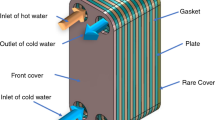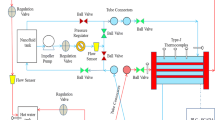Abstract
In the present research, friction factor and Nusselt number in tube side of a fin-and-tube heat exchanger are experimentally determined. Two kinds of nanofluids including Al2O3 and CuO water-based are used and experimental results are performed for three nanoparticle volumetric concentrations (PVC) for the Reynolds number between 3000 and 15,000. The results show that both friction factor and Nusselt number enhance in the case of nanofluid as working fluid in comparison to the water and this increment is higher in the CuO nanofluid. In the Al2O3 nanofluid at Re = 3000, 1.92%, 15.08% and 22.46% enhancements in the Nusselt number are observed compared with the base fluid for PVC = 0.025, 0.050 and 0.075, respectively. The mentioned improvements for CuO nanofluid are obtained 10.89%, 35.50% and 46.11%, respectively. In addition, at Re = 3000, 15.27%, 9.64% and 13.80% increases in friction factor are observed for Al2O3 nanofluid compared with base fluid, respectively, for PVC = 0.025, 0.050 and 0.075. The mentioned increases for CuO nanofluid are obtained 7.71%, 13.97% and 19.59%, respectively. Then, correlations for friction factor and Nusselt number are derived with adequate accuracy. Finally, the optimization of this kind of heat exchanger is performed in presence of nanoparticles and their results are presented.









Similar content being viewed by others
Abbreviations
- A tot :
-
Total heat transfer surface \(({\text{m}}^{2} )\)
- C min :
-
Minimum of Ch and Cc \(({\text{W}}/{\text{K}})\)
- C max :
-
Maximum of Ch and Cc \(({\text{W}}/{\text{K}})\)
- C * :
-
Heat capacity rate ratio \(( - )\)
- \(c_{p}\) :
-
Specific heat capacity (kJ/kg K)
- d np :
-
Average size of nanoparticle \(({\text{nm}})\)
- D h :
-
Hydraulic diameter \(({\text{m}})\)
- f :
-
Friction factor \(( - )\)
- G :
-
Mass flux \(({\text{kg}}/{\text{m}}^{2} {\text{s}})\)
- h :
-
Convection heat transfer coefficient \(({\text{W}}/{\text{m}}^{2} {\text{K}})\)
- j :
-
Colburn factor \(( - )\)
- k f :
-
Fluid thermal conductivity \(({\text{W}}/{\text{m}}^{2} {\text{K}})\)
- \(\dot{m}\) :
-
Mass flow rate (kg/s)
- NTU:
-
Number of transfer units \(( - )\)
- Nu:
-
Nusselt number \(( - )\)
- Pr:
-
Prandtl number \(( - )\)
- PVC:
-
Particle volumetric concentration (%)
- Q :
-
Rate of heat transfer (kW)
- Q max :
-
Maximum rate of heat transfer (kW)
- Re :
-
Reynolds number \(( - )\)
- St:
-
Stanton number \(( - )\)
- U :
-
Overall heat transfer coefficient \(({\text{W}}/{\text{m}}^{2} {\text{K}})\)
- V :
-
Heat exchanger volume (\({\text{m}}^{3}\))
- v :
-
Fluid velocity (m/s)
- \(\Delta P\) :
-
Pressure drop \(({\text{kPa}})\)
- \(\varepsilon\) :
-
Effectiveness \(( - )\)
- \(\eta_{o}\) :
-
Fin overall efficiency \(( - )\)
- \(\mu\) :
-
Viscosity (Pa s)
- \(\rho\) :
-
Density (\({\text{kg}}/{\text{m}}^{3}\))
- \(\phi\) :
-
Particle volumetric concentration (%)
- bf:
-
Fluid
- fin:
-
Fin side
- nf:
-
Nanofluid
- np:
-
Nanoparticle
- o:
-
Outside
- tube:
-
Tube side
References
Abdollahi A, Mohammed HA, Vanaki SM, Sharma RN (2018) Numerical investigation of fluid flow and heat transfer of nanofluids in microchannel with longitudinal fins. Ain Shams Eng J 56(1):161–170
Akyürek EF, Geliş K, Şahin B, Manay E (2018) Experimental analysis for heat transfer of nanofluid with wire coil turbulators in a concentric tube heat exchanger. Results Phys 9:376–389
Eiamsa-ard S, Wongcharee K (2018) Convective heat transfer enhancement using Ag-water nanofluid in a micro-fin tube combined with non-uniform twisted tape. Int J Mech Sci 146:337–354
Garcia A, Vicente PG, Viedma A (2005) Experimental study of heat transfer enhancement with wire coil inserts in laminar-transition-turbulent regimes at different Prandtl numbers. Int J Heat Mass Transf 48(21–22):4640–4651
Garoosi F, Hoseininejad F, Rashidi MM (2016) Numerical study of heat transfer performance of nanofluids in a heat exchanger. Appl Therm Eng 105:436–455
Gunes S, Ozceyhan V, Buyukalaca O (2010) Heat transfer enhancement in a tube with equilateral triangle cross sectioned coiled wire inserts. Exp Thermal Fluid Sci 34(6):684–691
Hajabdollahi H, Hajabdollahi Z (2016) Assessment of nanoparticles in thermoeconomic improvement of shell and tube heat exchanger. Appl Therm Eng 106:827–837
Hajabdollahi H, Hajabdollahi Z (2017a) Investigating the effect of nanoparticle on thermo-economic optimization of fin and tube heat exchanger. Proc Inst Mech Eng Part E J Process Mech Eng 231(6):1127–1140
Hajabdollahi H, Hajabdollahi Z (2017b) Numerical study on impact behavior of nanoparticle shapes on the performance improvement of shell and tube heat exchanger. Chem Eng Res Des 125:449–460
Hajabdollahi F, Premnath K (2017) Numerical study of the effect of nanoparticles on thermoeconomic improvement of a solar flat plate collector. Appl Therm Eng 127:390–401
Hajabdollahi Z, Hajabdollahi H, Fu PF (2017) The effect of using different types of nanoparticles on optimal design of fin and tube heat exchanger. Asia Pac J Chem Eng 12(6):905–918
Hajabdollahi Z, Mohsen M, Kim KC (2019) Effects of CuO and Al2O3 nanoparticles mixture on the thermal efficiency of the plate solar collector in different mass flow rates. Heat Transf Res 50(10):1
Han D, He WF, Asif FZ (2017) Experimental study of heat transfer enhancement using nanofluid in double tube heat exchanger. Energy Procedia 142:2547–2553
Kays WM, Lord AL (1984) Compact heat exchangers, 3rd edn. McGraw–Hill, New York
Khoshvaght-Aliabadi M, Davoudi S, Dibaei MH (2018) Performance of agitated-vessel U tube heat exchanger using spiky twisted tapes and water based metallic nanofluids. Chem Eng Res Des 133:26–39
Kumar P, Judd RL (1970) Heat transfer with coiled wire turbulence promoters. Can J Chem Eng 48(4):378–383
Kumar V, Tiwari KA, Ghosh SK (2017) Characterization and performance of nanofluids in plate heat exchanger. Mater Today Proc 4(2):4070–4078
Li Z, Aute V, Ling J (2019) Tube-fin heat exchanger circuitry optimization using integer permutation based genetic algorithm. Int J Refrig 103:135–144
Naphon P, Wiriyasart S (2018a) Experimental study on laminar pulsating flow and heat transfer of nanofluids in micro-fins tube with magnetic fields. Int J Heat Mass Transf 118:297–303
Naphon P, Wiriyasart S (2018b) Pulsating flow and magnetic field effects on the convective heat transfer of TiO 2-water nanofluids in helically corrugated tube. Int J Heat Mass Transf 125:1054–1060
Pak BC, Cho YI (1998) Hydrodynamic and heat transfer study of dispersed fluids with submicron metallic oxide particles. Exper Heat Transf 11:15
Rahimi A, Surendar A, Kasaeipoor A, Hooshmand P, Malekshah EH (2018) Lattice Boltzmann simulation of nanofluid flow and heat transfer in a hollow multi-pipe heat exchanger considering nanoparticles’ shapes. Powder Technol 339:974–984
Raja BD, Vivek Patel RL, Jhala, (2017) Thermal design and optimization of fin-and-tube heat exchanger using heat transfer search algorithm. Therm Sci Eng Progress 4:45–57
Rao RV, Patel V (2013) Multi-objective optimization of heat exchangers using a modified teaching-learning-based optimization algorithm. Appl Math Model 37(3):1147–1162
Rohsenow WM, Hartnett JP, Ganic EN (1985) Handbook of heat transfer applications. McGraw Hill, NY
Sahoo BC (2008) Measurement of rheological and thermal properties and the freeze-thaw characteristics of nanofluids. Department of Mining and Geological Engineering, University of Alaska Fairbanks , Fairbanks
Said Z, Rahman SMA, El Haj Assad M, Alami AH (2019) Heat transfer enhancement and life cycle analysis of a shell-and-tube heat exchanger using stable CuO/water nanofluid. Sustain Energy Technol Assess 31:306–317
Shah RK, Sekulic P (2003) Fundamentals of heat exchanger design. Wiley, New York
Vajjha RS, Das DK (2009) Experimental determination of thermal conductivity of three nanofluids and development of new correlations. Int J Heat Mass Transf 52(21):4675–4682
Acknowledgements
This research was supported by Iran National Science Foundation: INSF with proposal no. 95838948. We would like to acknowledge with much appreciation the INSF for supporting this work.
Author information
Authors and Affiliations
Corresponding author
Ethics declarations
Conflict of interest
The authors declare that they have no conflicts of interest.
Additional information
Publisher's Note
Springer Nature remains neutral with regard to jurisdictional claims in published maps and institutional affiliations.
Rights and permissions
About this article
Cite this article
Hajabdollahi, H., Shafiey Dehaj, M. Experimental study and optimization of friction factor and heat transfer in the fin and tube heat exchanger using nanofluid. Appl Nanosci 11, 657–668 (2021). https://doi.org/10.1007/s13204-020-01616-3
Received:
Accepted:
Published:
Issue Date:
DOI: https://doi.org/10.1007/s13204-020-01616-3




